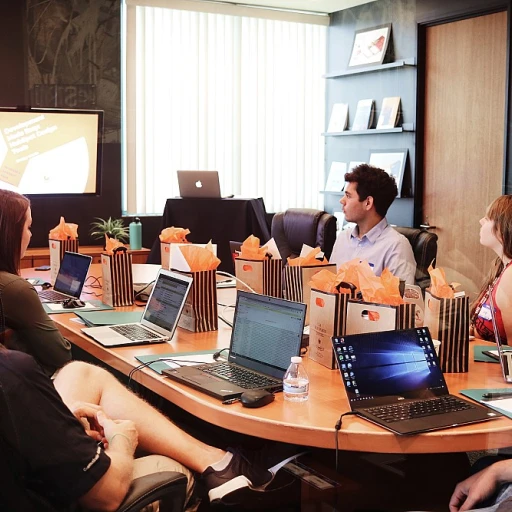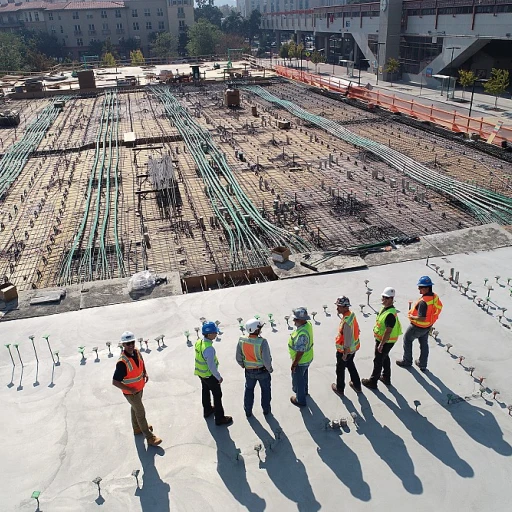Understanding Traditional Work Systems
Traditional Work Environments and Their Dynamics
The traditional work systems, prevalent across multiple industries, have shaped our understanding of professional life for decades. Such systems often revolve around structured work environments, where employees perform tasks under specific management systems typically within a physical office space. This method has been the cornerstone for businesses seeking stability and consistency.
In these environments, team members benefit from face-to-face human interaction, fostering team cohesion and aiding in performance work. These settings allow for direct supervision, which can enhance system performance by ensuring that tasks are executed efficiently. Such work environments also provide a foundation for developing high performance cultures within teams.
Key elements of traditional work systems include structured working hours, where employees adhere to set schedules, contributing to a sense of routine and predictability. The system design often emphasizes hierarchy, with clear lines of authority and management channels to follow. This approach aids in maintaining order and facilitating efficient task delegation.
Despite the dominance of structured work arrangements, they are not without challenges. Rigid systems sometimes stifle individual creativity and could lead to fatigue, affecting work-life balance and overall employee well-being. The focus on attendance and office presence might overshadow the quality of output, highlighting a limitation of this system method.
While traditional models continue to play an essential role in certain sectors, the current shift towards remote work and hybrid models signifies a broader evolution in work environments. Businesses are exploring ways to transition from traditional frameworks towards more adaptable, independent work systems, reflecting a profound change in the work landscape.
For insights into how technology integrates with remote work systems, read about the
best tools for remote work success.
The Rise of Remote Work
The Evolution of Remote Work
Remote work has transitioned from a niche concept to a mainstream work system embraced by businesses and employees worldwide. This shift is largely driven by advancements in technology and changing perceptions about work environments. As companies seek to optimize performance and adapt to modern demands, remote work offers a flexible solution that caters to different needs.
Benefits of Remote Work Systems
One of the primary advantages of remote work is the ability to design a work environment that suits individual preferences. Employees and students alike can choose settings that enhance their productivity and well-being. This flexibility often leads to higher performance work outcomes, as people can focus on tasks without the distractions of a traditional office.
- Increased Flexibility: Remote work allows for more adaptable working hours, enabling employees to balance work life with personal commitments.
- Cost Savings: Both businesses and employees can save on expenses such as commuting and office space.
- Access to a Global Talent Pool: Companies can hire team members from different geographical locations, bringing diverse perspectives and skills to the team.
Challenges and Considerations
Despite its benefits, remote work systems also present challenges that need to be addressed. Management must ensure that employees remain engaged and connected to the team, fostering a sense of belonging even when working independently. Structured work processes and clear communication are essential to maintaining high performance.
- Communication: Effective communication tools are vital to bridge the gap between remote team members.
- Performance Monitoring: Implementing systems to track employee performance without infringing on privacy is crucial.
- Technology Dependence: Reliable technology is the backbone of successful remote work, necessitating investment in the right tools and infrastructure.
For those interested in exploring the best tools for remote work success, this guide offers valuable insights into optimizing your remote work setup.
Hybrid Work Models: The Best of Both Worlds
The Harmony Between Office and Remote
In recent years, many companies are transitioning to hybrid work models, recognizing the benefits of combining traditional and remote work systems. This approach offers a flexible work environment that can balance the structured work and the independence of remote work, adapting to the diverse needs of businesses and employees alike.
Hybrid work systems are designed to blend the strengths of both office and remote settings. Many organizations have adopted this system method to foster team cohesion while allowing employees the autonomy to work from locations of their choice. Research indicates that these work environments can enhance system performance by catering to individual work preferences and optimizing team dynamics.
This model acknowledges that different people perform well in various environments. Some excel in office settings, benefiting from the structured work schedules and immediate teamwork interaction. Others thrive in remote settings, appreciating the freedom of independent work and the flexibility to design their work hours around personal commitments. This adaptability can drive high performance and satisfaction among team members.
For businesses implementing this work system, effective management is key. Clear communication, task management tools, and performance tracking are essential elements to ensure productivity and alignment with organizational goals. In this rapidly evolving landscape, it's crucial to maintain a robust system to evaluate individual contributions and team outputs, fostering an environment where both employees and students can flourish.
To create a great work balance in hybrid systems, human factors should not be overlooked. Organizations must prioritize work life harmony, taking into account both employee well-being and business demands. As companies navigate this new work environment, they should remain open to continuously refining their systems to accommodate the evolving demands of their teams.
Lastly, when integrating a hybrid model, companies can benefit from crafting the ideal environments for both in-office and at-home workplaces. Establishing conducive spaces supports employee performance and overall productivity, ensuring a successful outcome for hybrid work systems. For more insights on setting up an effective remote workspace, explore
crafting the ideal home office for remote work success.
Freelancing and Gig Economy: A New Frontier
Freelancing and the Gig Economy: Opportunities and Challenges
In recent years, freelancing and the gig economy have gained traction as appealing work systems for many. They offer flexibility in work environments and allow individuals to manage their working hours effectively. For students, employees, and those seeking different work systems, freelancing provides a platform to explore independent work. The varied opportunities within the gig economy make it an attractive option for those wishing to have a more customized work life.
Freelancers benefit from diverse tasks and the ability to choose projects aligning with their skills. This approach supports high performance as individuals can focus on tasks that match their expertise and interests. However, this flexibility requires strong self-management and effective task allocation to ensure system performance.
One key element of success in freelancing is creating a structured work environment that fosters great work and optimizes performance. Freelancers often design their own work systems, balancing the need for creativity and discipline. Team members, whether virtual or in-person, play a vital role in enhancing team performance, offering support, and sharing skills.
While freelancing offers numerous advantages, there are challenges related to securing a steady stream of work, managing finances, and dealing with isolation. Creating a supportive network and adopting well-designed work processes can alleviate some of these concerns.
In the ever-evolving professional landscape, freelancers and gig workers are demonstrating how different work systems can adapt to changing human factors, business needs, and technological advancements. Their experience highlights the importance of being adaptable and resilient in the face of a dynamic work environment.
Technology's Role in Shaping Work Systems
Tech Tools Transforming Productivity
The modern work environment has evolved significantly, largely thanks to technology, which has become a cornerstone in shaping work systems. Whether for remote or hybrid work models, the integration of tech tools is essential for enhancing productivity and maintaining structured work systems. Here’s a look at how technology is influencing various aspects of the work arena.
Communication and Collaboration Tools
Technology plays a pivotal role in facilitating communication and collaboration, which are crucial in any work system. With the rise of remote work, tools like video conferencing, chat applications, and collaborative platforms have become essential. These tools enable team members to communicate effectively, share ideas, and work collaboratively on tasks without being in the same physical location. This transformation has created a seamless work environment that transcends geographical boundaries, allowing employees and students alike to engage and complete tasks efficiently.
Project Management and Task Allocation
Managing projects and allocating tasks is more streamlined with technology-driven solutions. Tools that offer project management capabilities help keep track of tasks, deadlines, and progress in real time. They provide a structured environment where team members can easily view assignments, update progress, and collaborate on deliverables. This not only enhances system performance but also ensures high performance by keeping everyone aligned with the business goals.
Data Analytics and Performance Tracking
Data analytics tools offer insights into employee performance and work system effectiveness. By analyzing metrics such as task completion rates and resource allocation, managers can identify bottlenecks and optimize workflows. This data-driven approach enables a strategic design of work systems that enhance productivity and foster a healthy team environment.
Flexibility and Work-Life Balance
Technological advancements also contribute to improved work-life balance. Remote work capabilities allow people to design their work environment to suit their personal needs, leading to better human well-being. With the ability to perform tasks at flexible hours, employees can manage their personal commitments without compromising on work responsibilities, fundamentally reshaping the traditional concept of working hours.
In essence, the integration of technology into work systems has revolutionized the professional landscape. As businesses and educational institutions continue to adapt, embracing these technological tools ensures that work systems remain effective, collaborative, and adaptable to changing environments.
Adapting to Change: Overcoming Challenges in Remote Work
Overcoming Challenges in Remote Work Environments
Navigating the shift to remote work can be daunting for employees, businesses, and even students. Transitioning from a structured work environment to an independent work system demands a rethinking of work life balance and task management.
Faced with the task of staying connected with team members while being physically apart, communication becomes key. Teams need to utilize technology to foster collaboration and communication among employees in different environments. This allows teams to maintain a sense of community and ensure high performance despite the geographical barriers.
The Role of Technology and Tools
Technology is fundamental in shaping these modern work systems. By employing various tools for communication, task management, and performance tracking, businesses can design work platforms that will align with different types of work systems. Technology not only eases communication across digital workspaces but also supports diverse working hours and independent work without compromising system performance.
Impact on Employee Well-being and Performance
Remote work, if not well-organized, can lead to disengagement and burnout. Encouraging a healthy work-life balance is crucial and often involves setting boundaries in work hours. Employers should design work policies that emphasize employee well-being, recognizing that great work stems from human factors, not just performance work metrics.
Furthermore, managers need to adapt to new leadership styles to effectively guide team members across remote work environments. A system that supports flexibility must also pay attention to structured work elements to ensure accountability and human work harmony.
Though remote systems present distinct challenges, they offer an opportunity for businesses to reimagine performance measures and task management. In the evolving professional landscape, both employers and employees must embrace these changes to thrive in a digital, interconnected world.








